
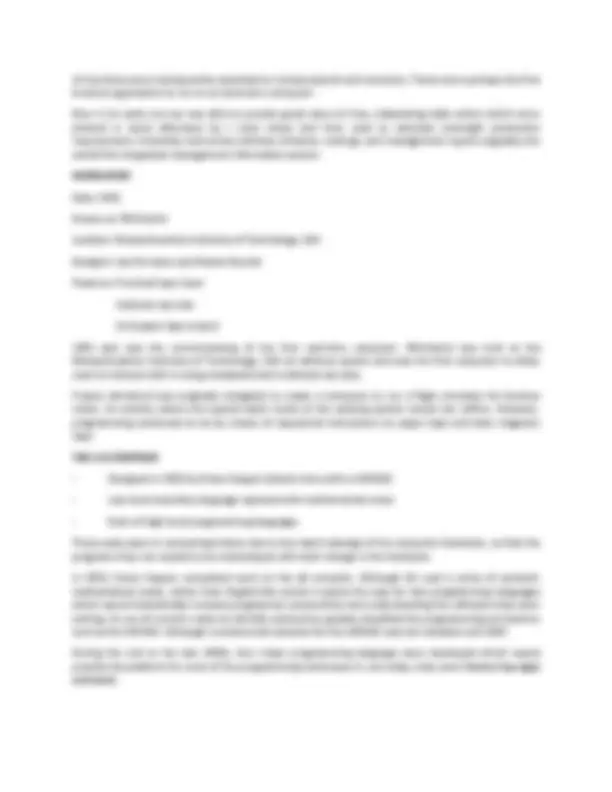
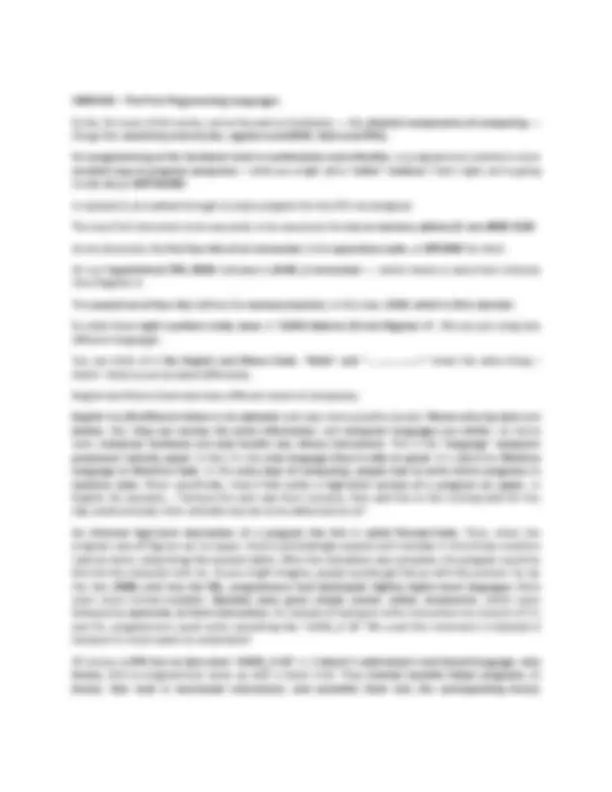
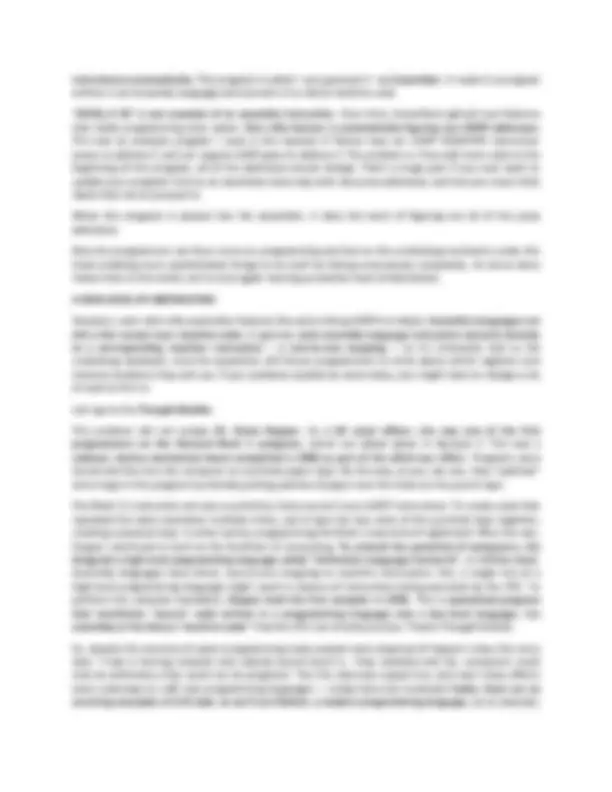

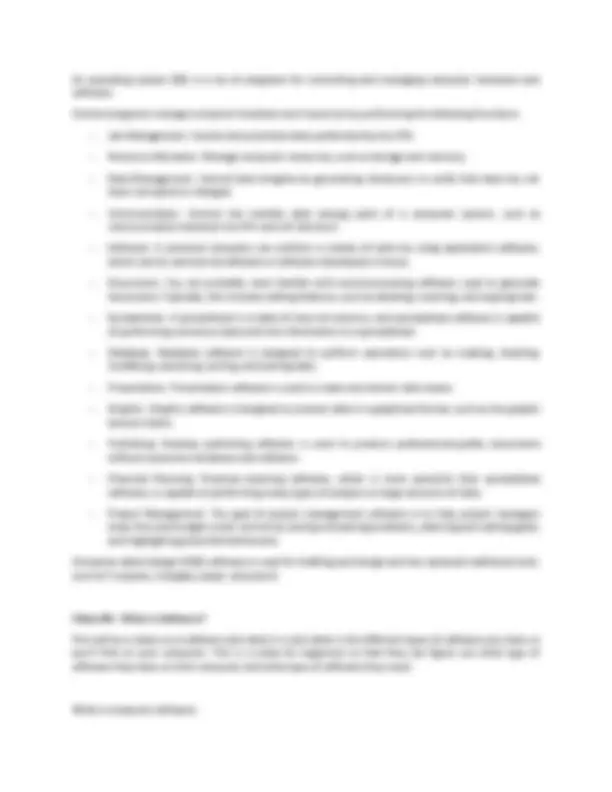
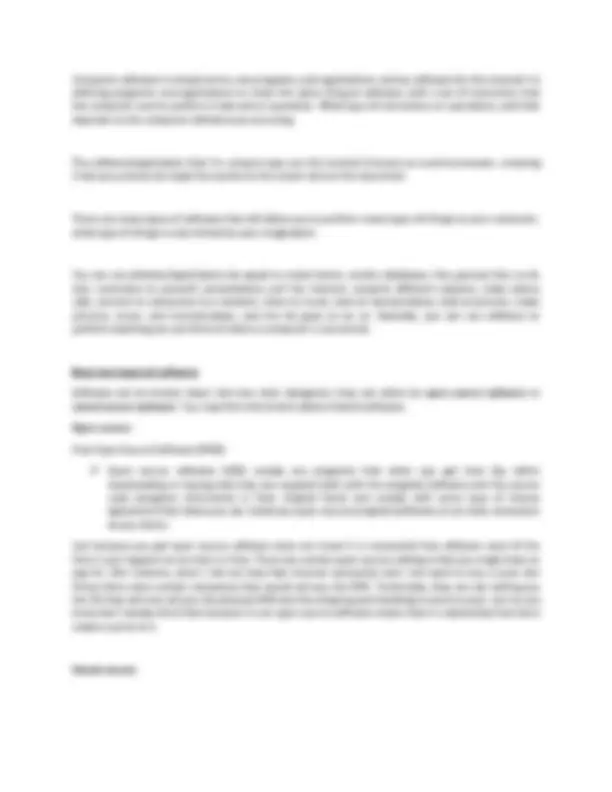
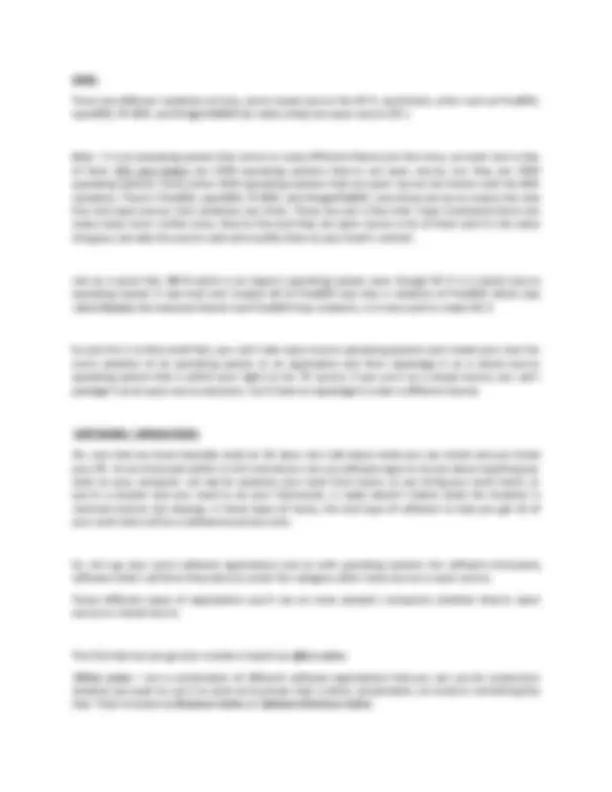
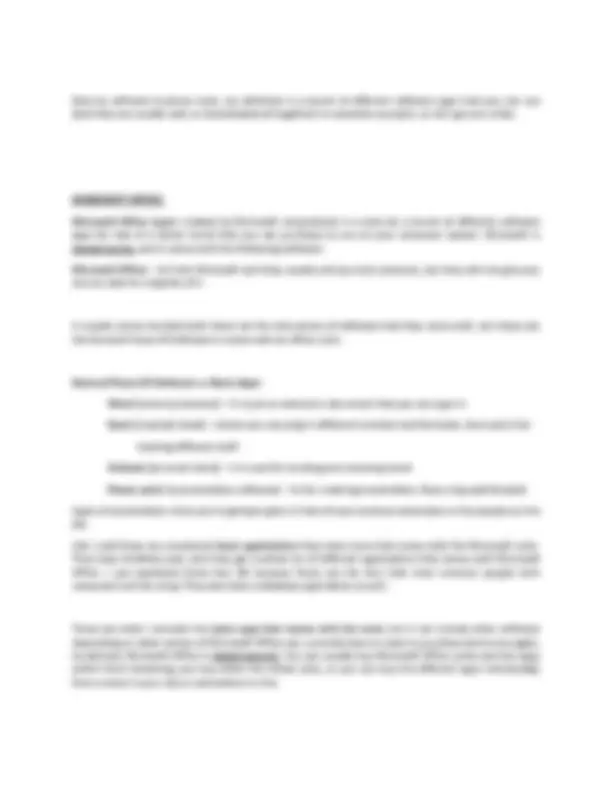
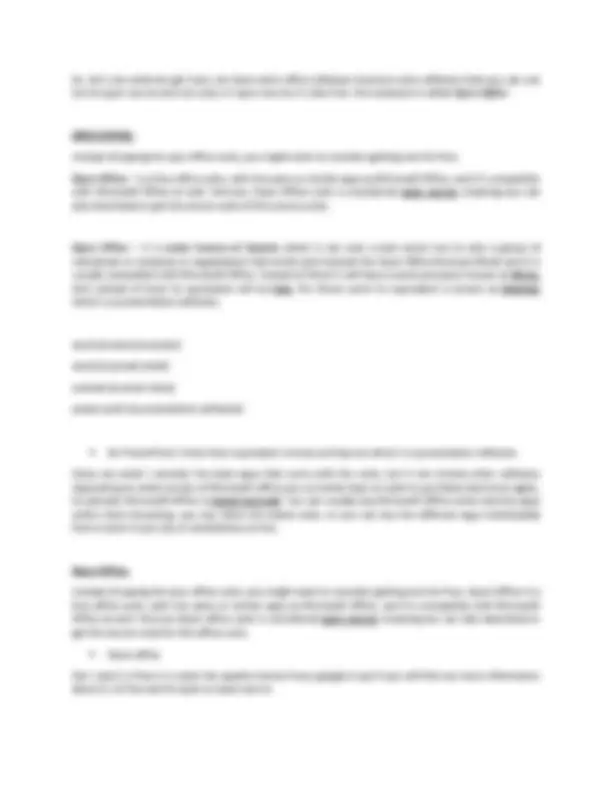

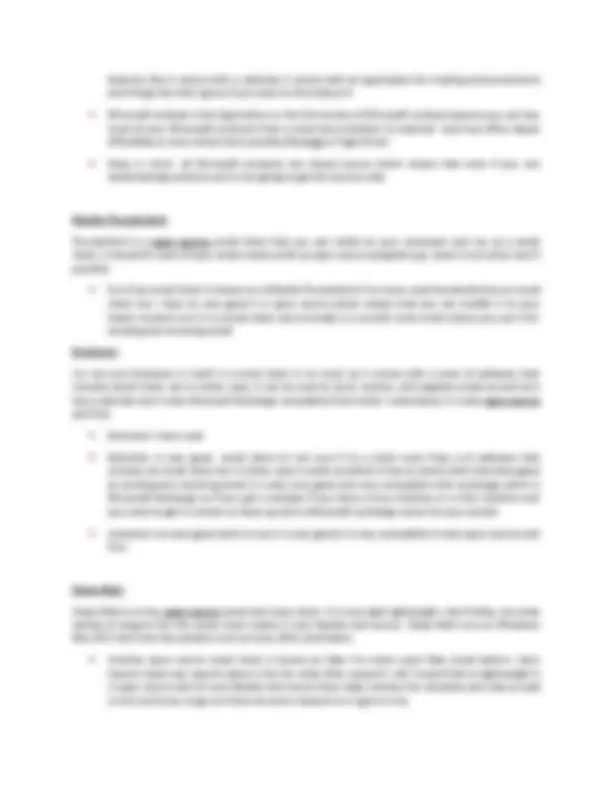
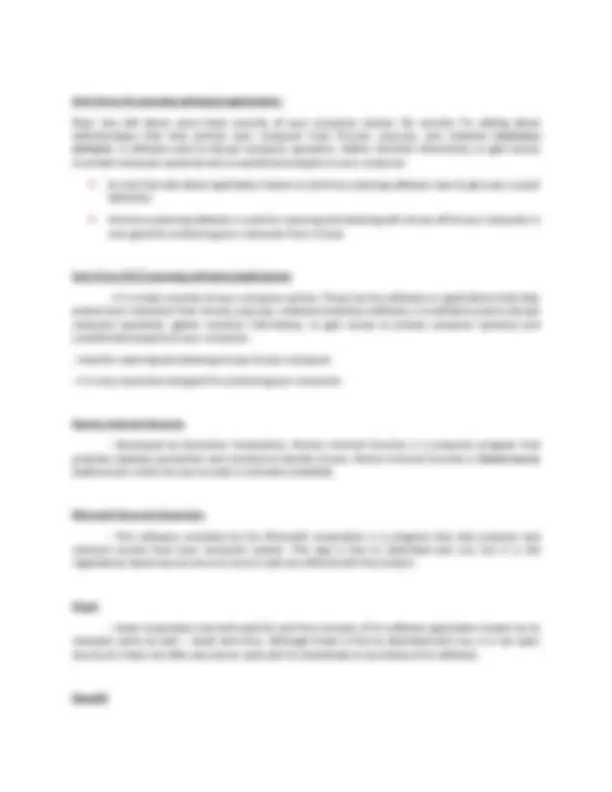
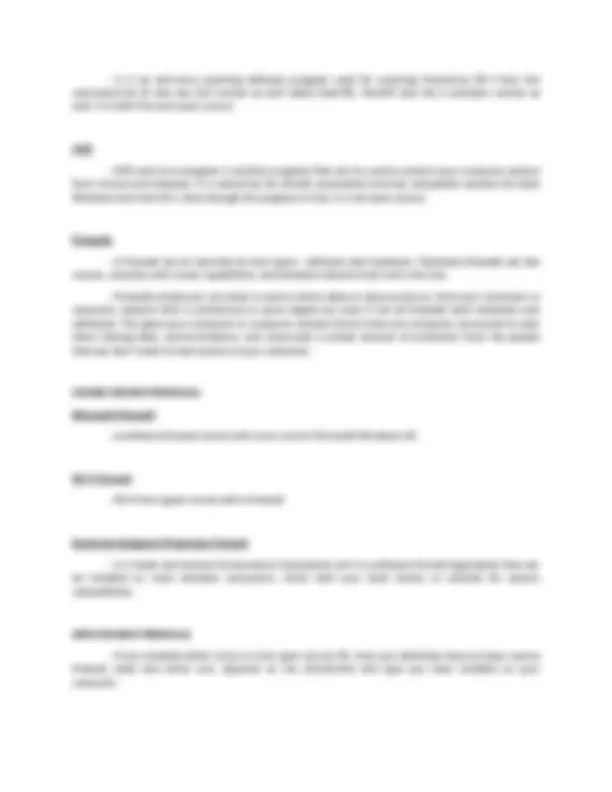
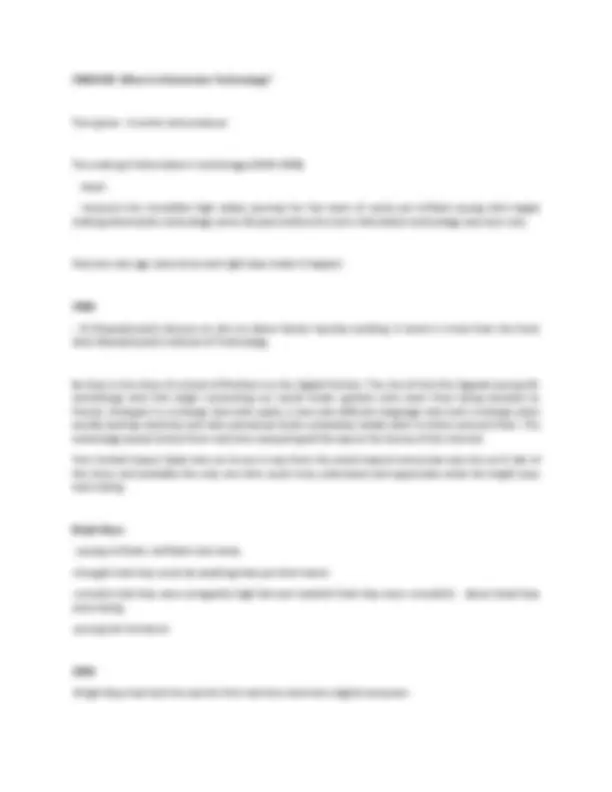


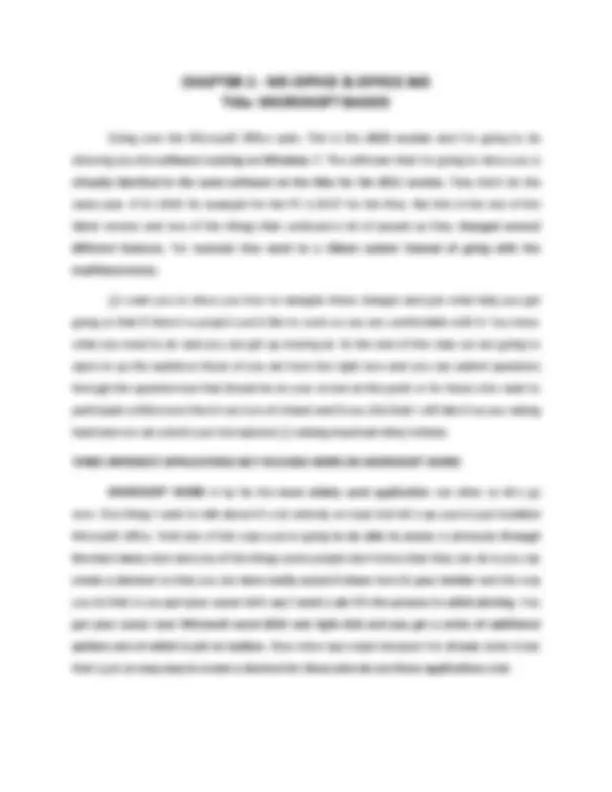
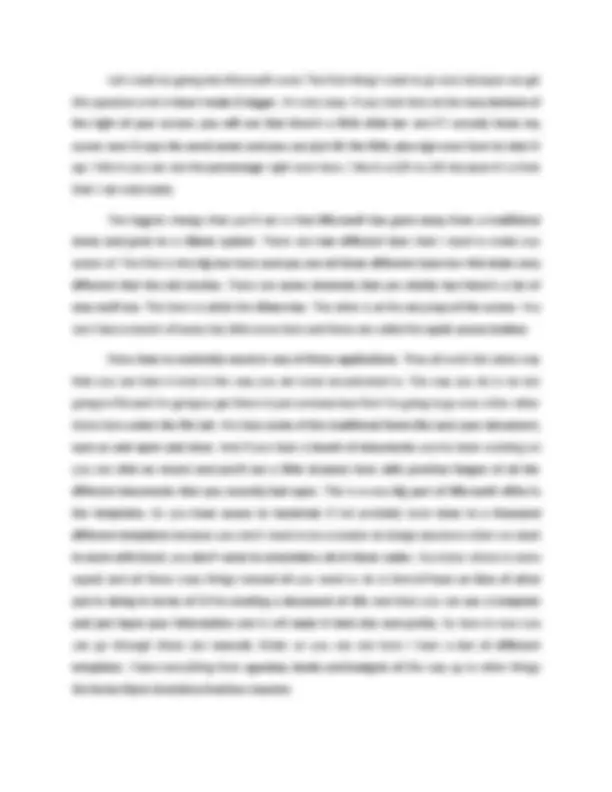
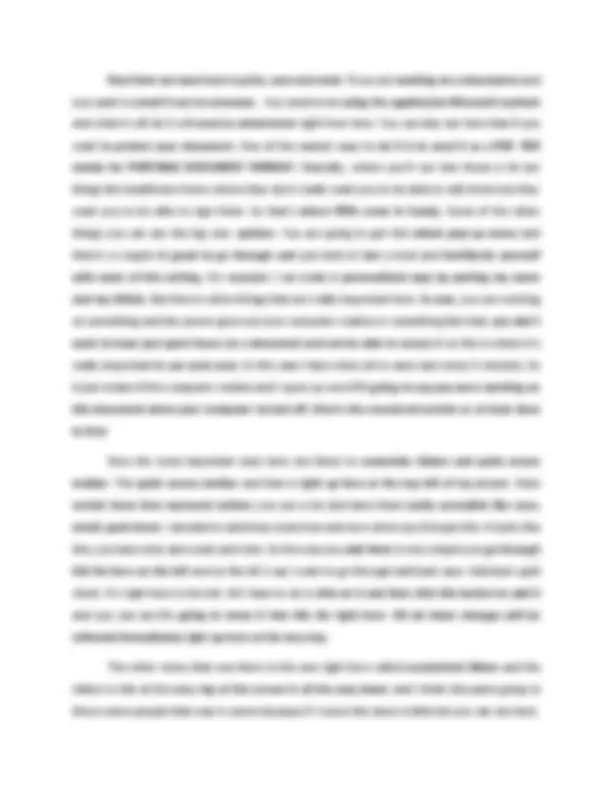
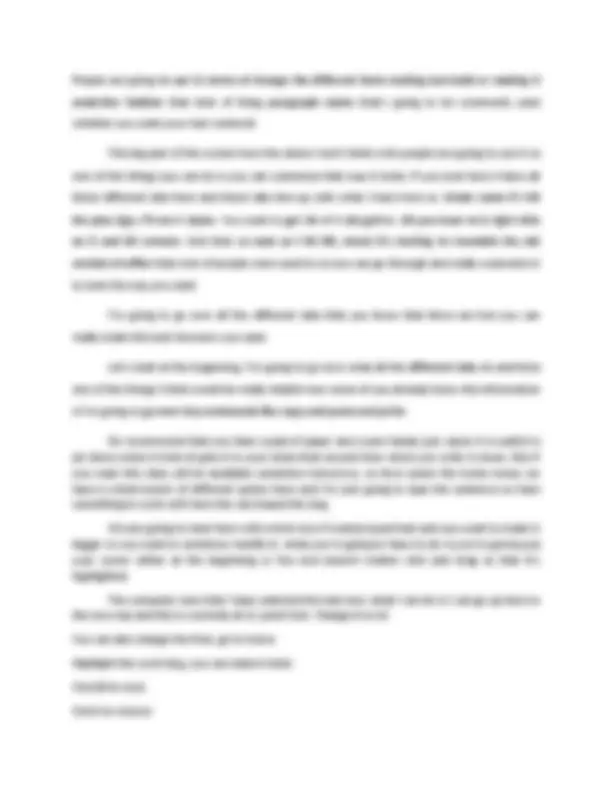
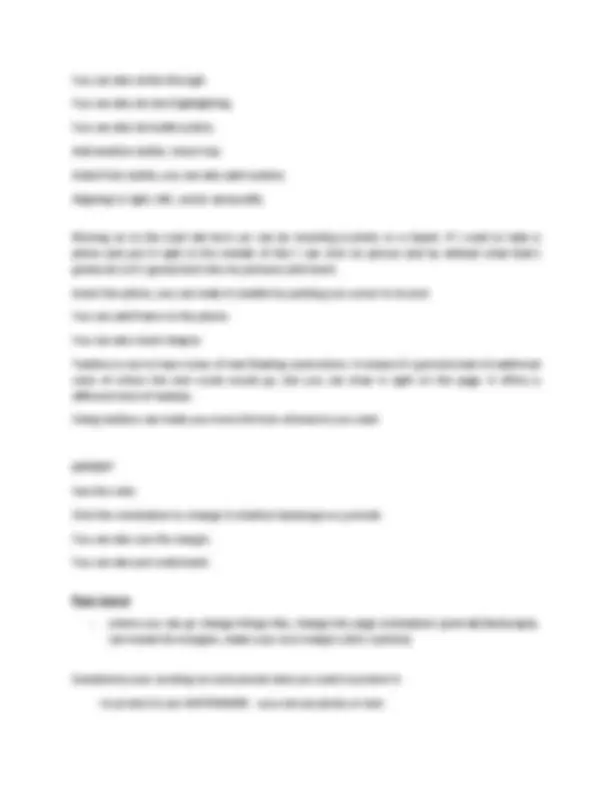
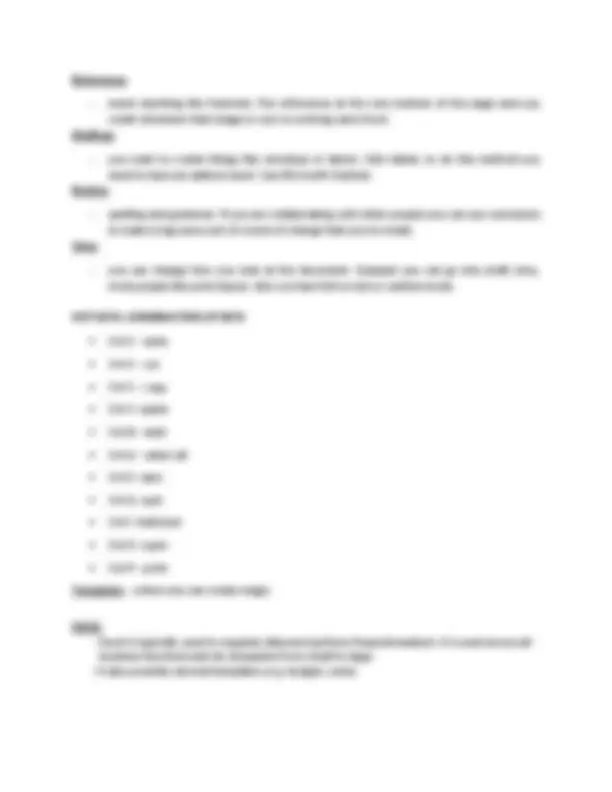
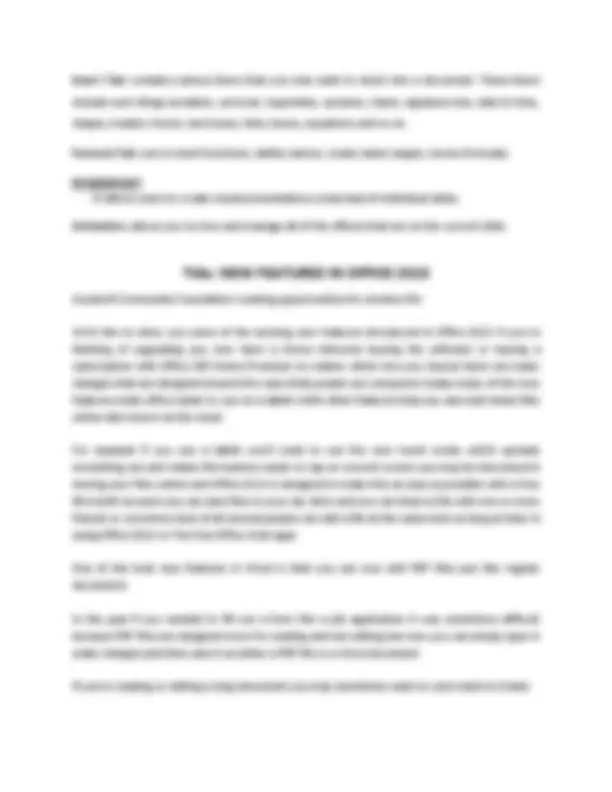
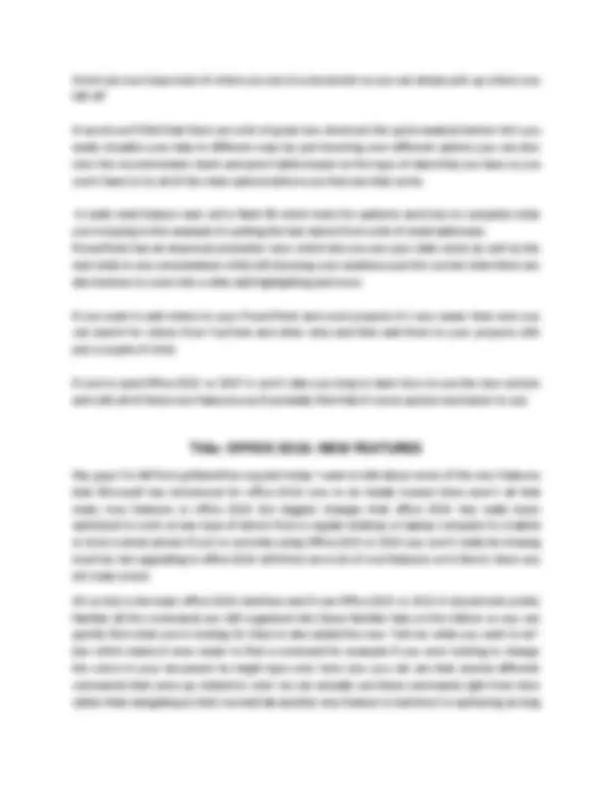
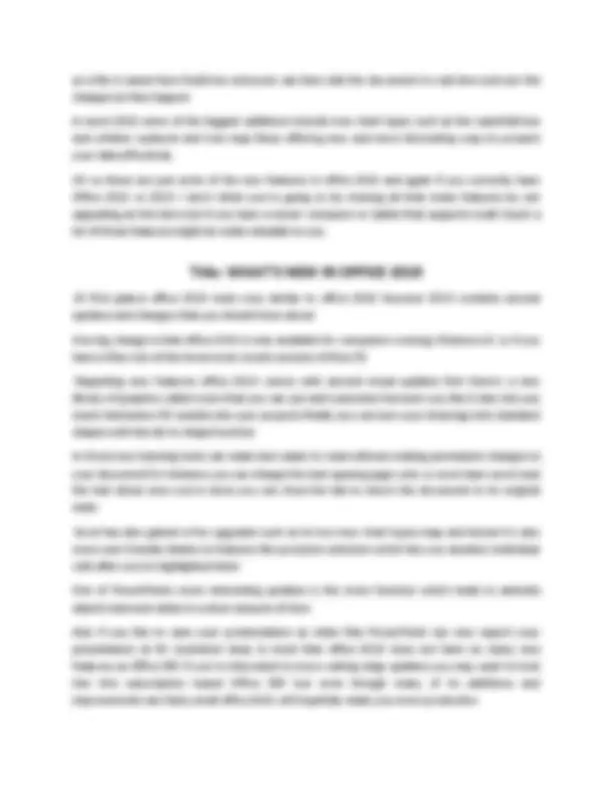
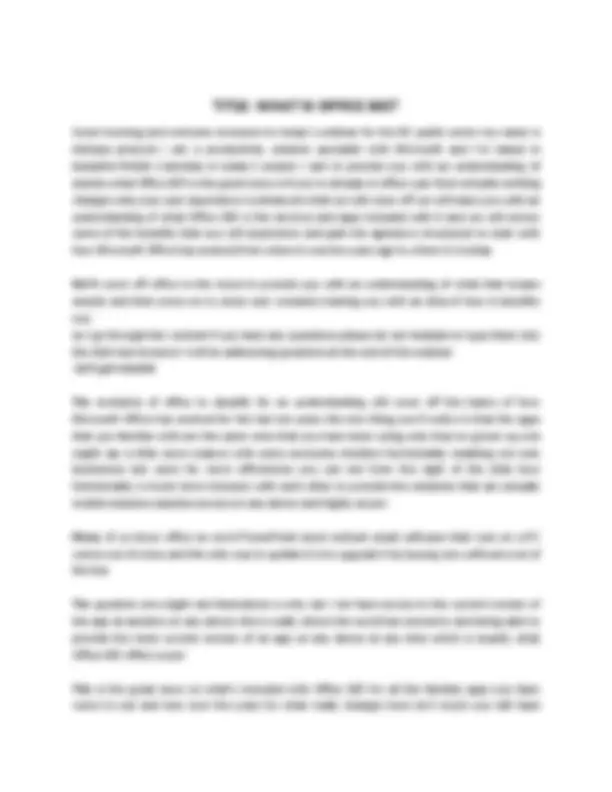
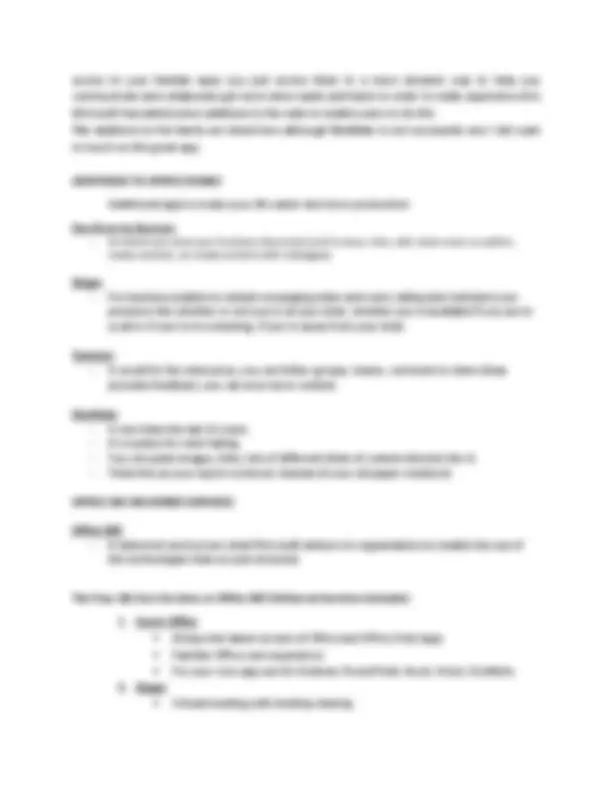
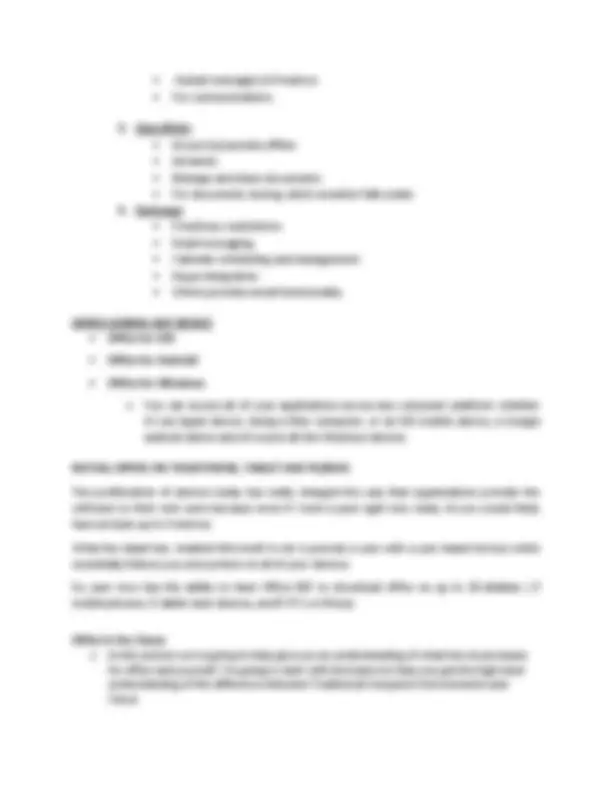
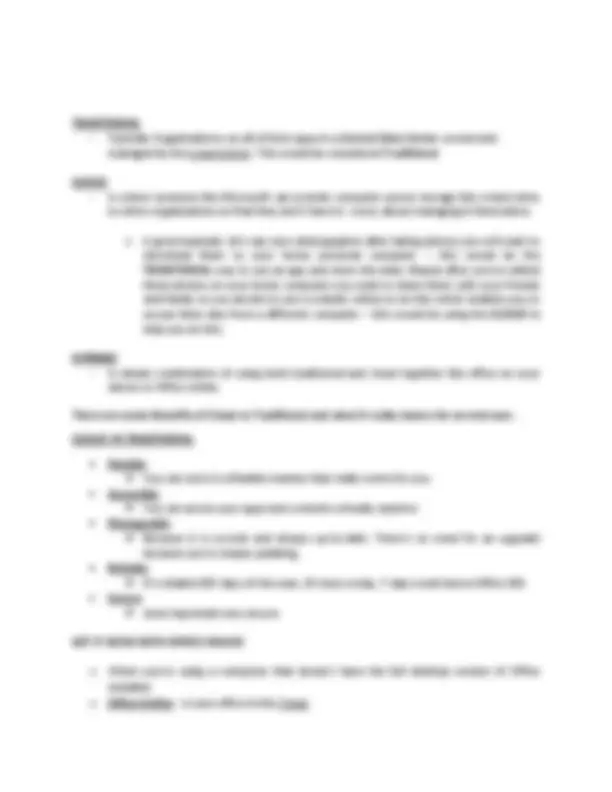
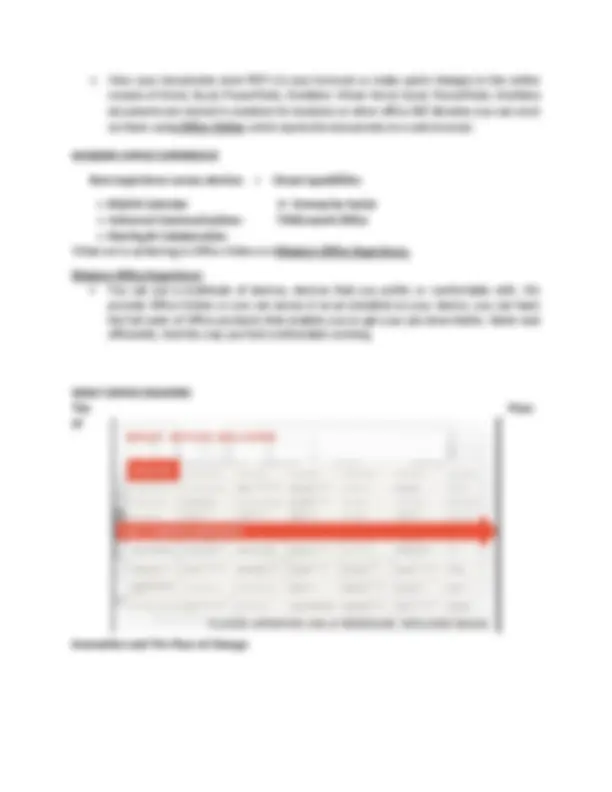
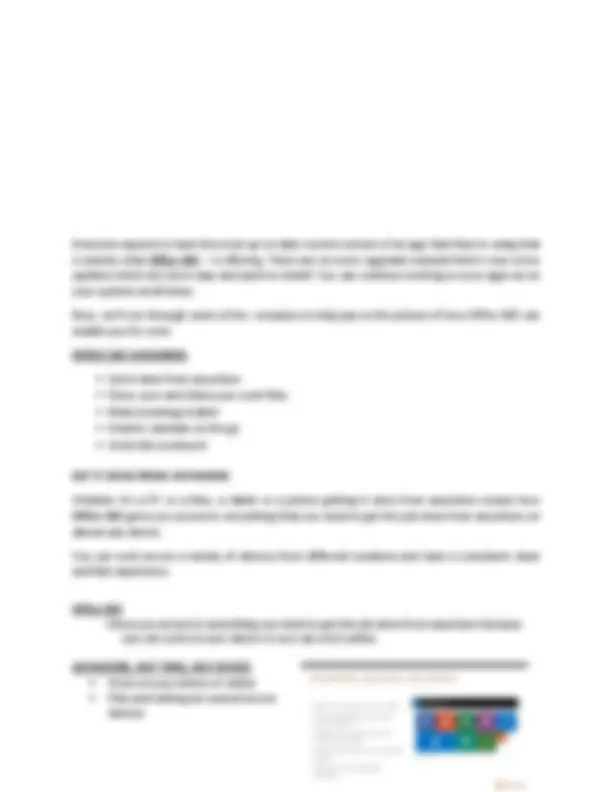
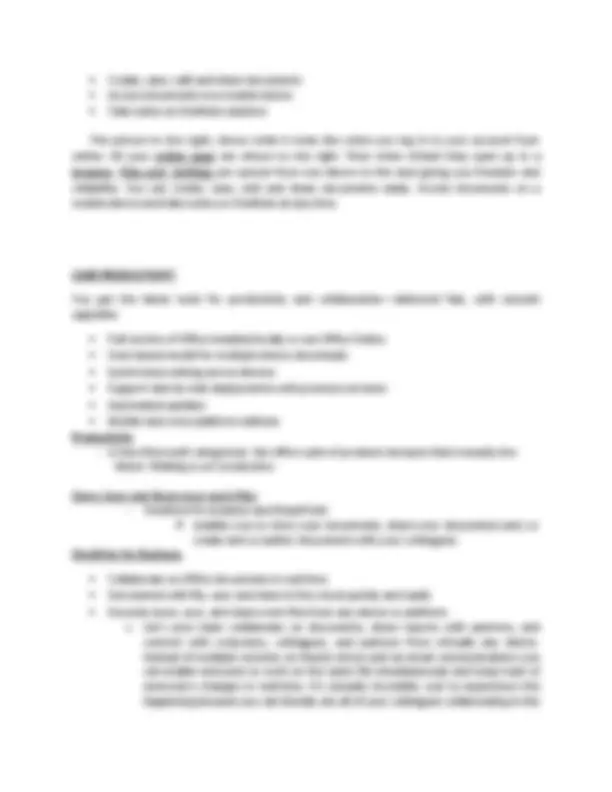
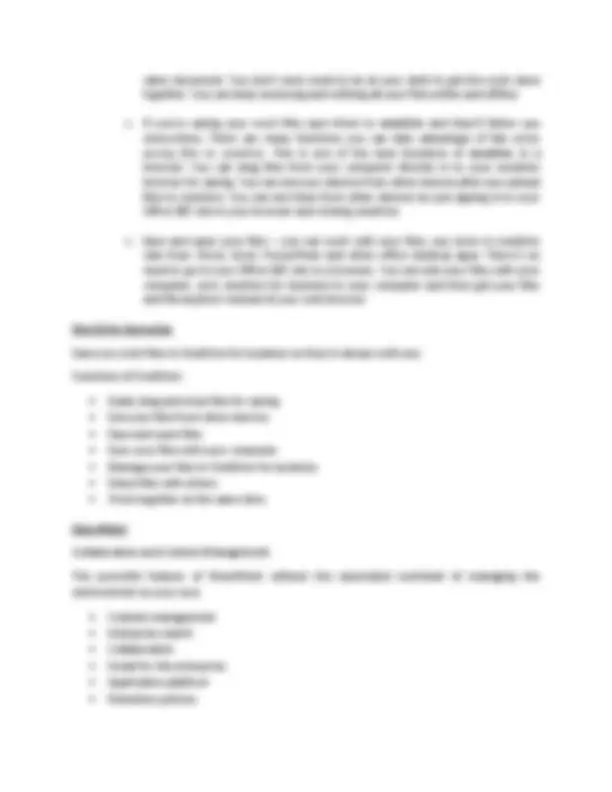
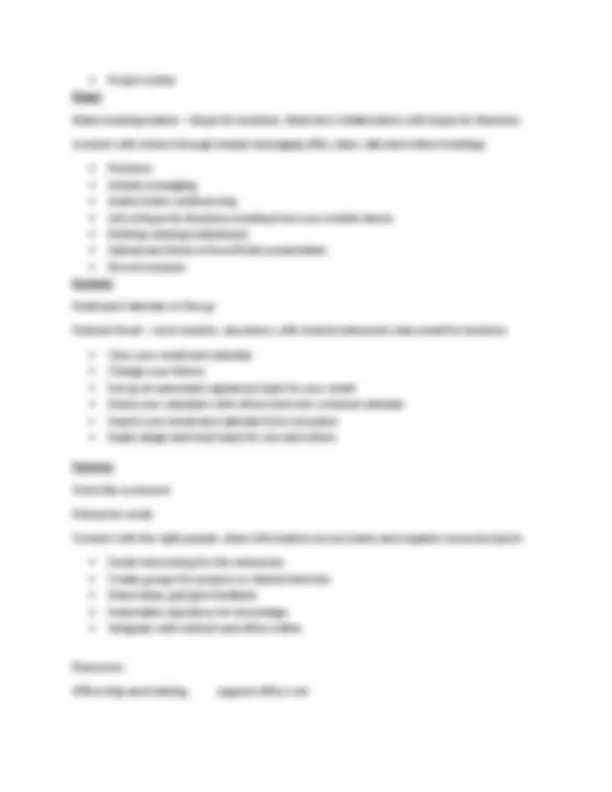
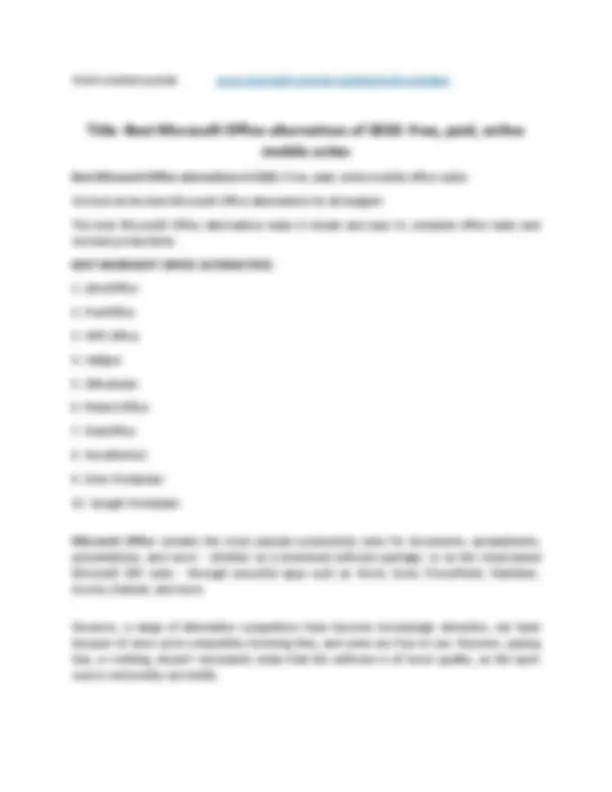
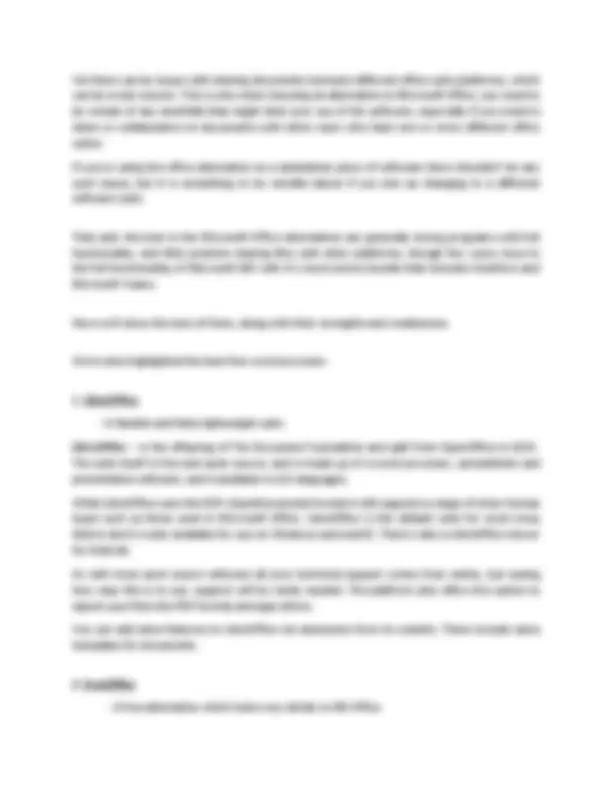
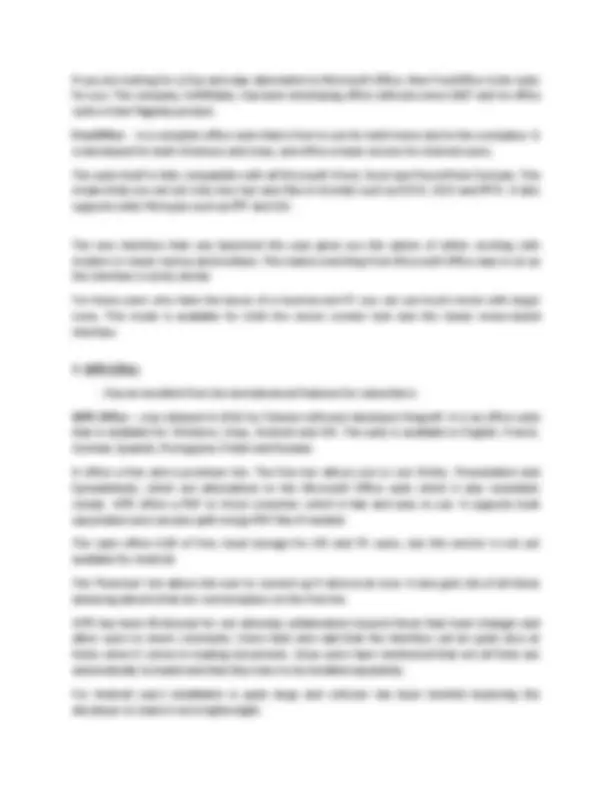
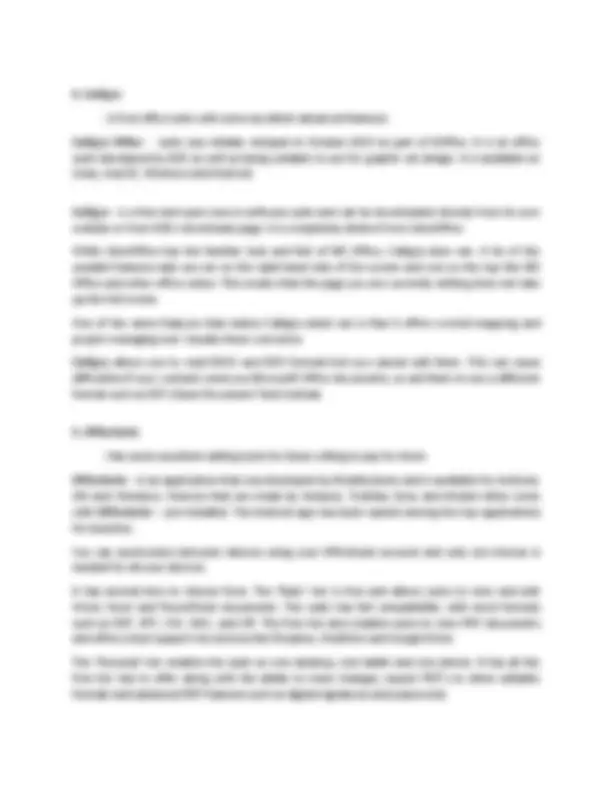
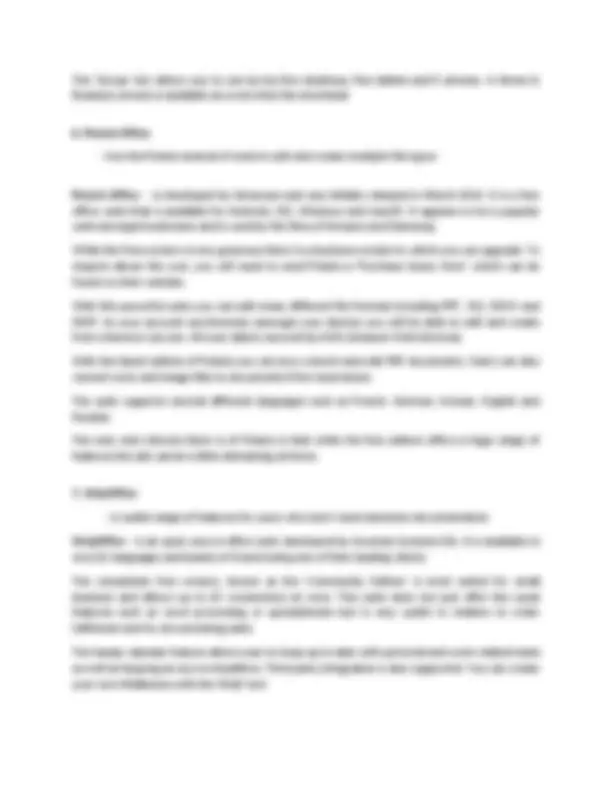
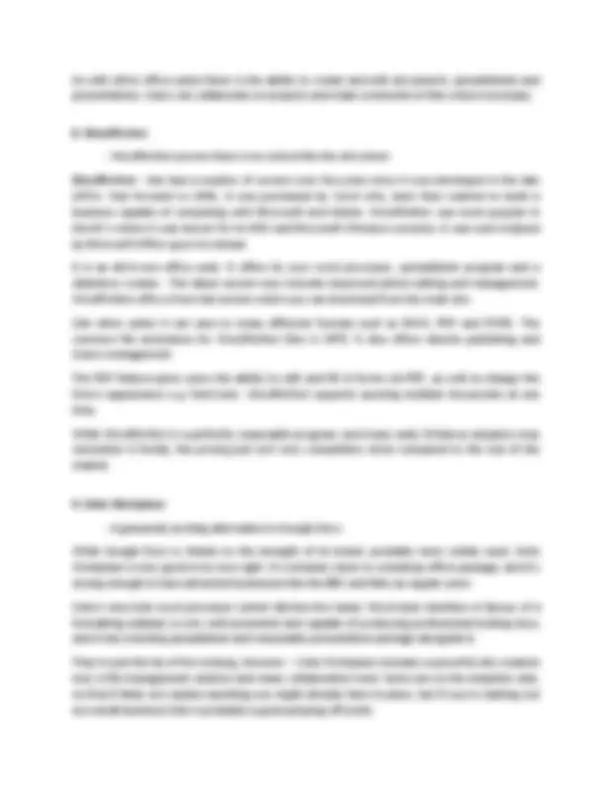



Study with the several resources on Docsity

Earn points by helping other students or get them with a premium plan


Prepare for your exams
Study with the several resources on Docsity

Earn points to download
Earn points by helping other students or get them with a premium plan
Community
Ask the community for help and clear up your study doubts
Discover the best universities in your country according to Docsity users
Free resources
Download our free guides on studying techniques, anxiety management strategies, and thesis advice from Docsity tutors
It is about different subjects that can help you gain additional knowledge.
Typology: Lecture notes
1 / 49

This page cannot be seen from the preview
Don't miss anything!










































Chapter 1 – Information Technology and Software VIDEO 01 – Overview the Evolution of Software The Evolution of Software The computer is an amazing invention on a daily basis it seems a new application arise, changing the way we live, work and play. Computer are sed almost everywhere we go and have moved providing occasional assistance almost to the point being essential for day-to-day life. In this initial module we’ll explore the early days of computing and examine how the decisions made five or six decades ago have shaped the world which we live and industry in which we work. EDSAC Date: 6th May 1949 Known as: EDSAC Location: Cambridge University, UK Designer: Maurice Wilkes and Team Features; Punched tape input Teleprinter output The 6th of may 1949 is considered by many to be the birthday of modern computing, that day some 60 years ago saw the execution of the first stored program on the edsac the electronic delay storage automatic calculator at Cambridge university in UK by Maurice Wilkes and his colleagues. Edsac first programs calculated a table of squares and a list of prime numbers and its initial orders a set of routines which allowed subsequent loading programs were programmed using a series of telephone exchange switches known as uni selectors, further input was given through the use of holes punched in paper tape. Similar to the punch cards used by ibm’s electric accounting machines, while output from the program was given in the form of printout on a teleprinter, a kind of automated typewriter. Newspaper reports at the time labelled the computer a mechanical brain, and they describe its vastness weighing about a ton with 120 racks of valves and covering an area of about 500 square feet. In a pre echo of later predictions of the number of computers that would be required, the star a popular London newspaper report that a dozen or so such brains would probably be sufficient for the whole country. And one day the brain might help with our income tax and bookkeeping calculations. Maurice Wilkes saw purely scientific future for Edsac stating that the brain would carry out mathematical research and might even make sensational discoveries and engineering astronomy and atomic, physics. PILOT ACE Date: 10th May 1950 Known as: Pilot ACE Location: National Physical Laboratory, UK Designer: J.H. Wilkinson to Alan Turing;s design
Features: Punched cards input and output In May 1950 the Pilot Ace or automatic computing engine ran its first program the pilot was intended as a prototype for the ace itself, which embodied the ideas of mathematician Alan Turing now well known for his code break machine during the second world war as well as for his theoretical work on computation. Turing is particularly renowned for his conceptual discovery of the universal of the turing machine a computer structured not to carry out secific tasks but which can carry out any task specified by programmed instructions. At a symposium on large-scale digital calculating machinery, in 1947 in Cambridge massachusettes Turing said we’re trying to build a machine to do all kinds of different things, simply by programming rather than by the addition of extra apparatus. UNIVERSAL AUTOMATIC COMPUTER Date: 1951 Known as: UNIVAC Location: Philadelphia, USA Designer: J Presper Eckert and John Mauchly Features: Magnetic tape input Typewriter output Just two years after the first program were run on EDSAC Univac 1 the first commercial computer was produced in the United States. Designed for the outset for business and administrative purposes, it was built for the fast execution of large numbers of relatively simple calculations and data transformations, rather than a complex mathematical algorithm for which the EDSAC had been designed. Magnetic tape was used for input rather than punched tape and early installations were used by the US census bureau air force army map service, and the atomic energy commission. 1954 saw the first installations of the UNIVAC for commercial use by Remington Rand then owners of UNIVAC in their sales office then by General Electric metropolitan life US steel and dupont. LYONS ELECTRONIC OFFICE Date: 1951 Known as: LEO Location: UK Designer: Maurice Wilkes Features: Punched Tape and cards input Printer tabulator output Meanwhile, in 1951 J Lyons UK food company with a chain of tea shops had commissioned the Lyons electronic Office or Leo initially to run valuation jobs. Leo was designed by EDSAC Maurice Wilkes. And
VIDEO 02 – The First Programming Languages So far, for most of this series, we’ve focused on hardware --- the physical components of computing --- things like: electricity and circuits, registers and RAM, ALUs and CPUs. But programming at the hardware level is cumbersome and inflexible , so programmers wanted a more versatile way to program computers – what you might call a “softer” medium. That’s right, we’re going to talk about SOFTWARE! In episode 8, we walked through a simple program for the CPU we designed. The very first instruction to be executed, to be executed, the one at memory address 0, was 0010 1110. As we discussed, the first four bits of an instruction is the operations code , or OPCODE for short. On our hypothetical CPU, 0010 indicated a LOAD_A instruction --- which moves a value from memory intro Register A. The second set of four bits defines the memory location , in this case, 1110, which is 14 in decimal. So what these eight numbers really mean is “LOAD Address 14 into Register A”. We are just using two different languages. You can think of it like English and Morse Code. “Hello” and “…. ..-.. .-..---” mean the same thing – hello!—they’re just encoded differently. English and Morse Code also have different levels of complexity. English has 26 different letters in its alphabet and way more possible sounds. Morse only has dots and dashes. But, they can convey the same information , and computer languages are similar. As we’ve seen, computer hardware can only handle raw, binary instructions. This is the “ language ” computer processors natively speak. In fact, it’s the only language they’re able to speak. It’s called the Machine Language or Machine Code. In the early days of computing , people had to write entire programs in machine code. More specifically, they’d first write a high-level version of a program on paper , in English, for example… “retrieve the next sale from memory, then add this to the running total for the day, week and year, then calculate any tax to be added and so on” An informal high-level description of a program like this is called Pseudo-Code. Then, when the program was all figures out on paper, they’d painstakingly expand and translate it into binary machine code by hand, using things like opcode tables. After the translation was complete, the program could be fed into the computer and run. As you might imagine, people quickly got fed up with this process. So, by the late 1940s and into the 50s , programmers had developed slightly higher-level languages there were more human-readable. Opcodes were given simple names, called, mnemonics , which were followed by operands, to form instructions. So instead of having to write instructions as a bunch of 1’s and 0’s, programmers could write something like “LOAD_A 14” We used this mnemonic in Episode 8 because it’s much easier to understand! Of course, a CPU has no idea what “LOAD_A 14” is. It doesn’t understand a text-based language, only binary. And so programmers came up with a clever trick. They created reusable helper programs, in binary, that read in text-based instructions, and assemble them into the corresponding binary
instructions automatically. This program is called – you guessed it – an Assembler. It reads in a program written in an Assembly Language and converts it to native machine code. “LOAD_A 14” is one example of an assembly instruction. Over time, Assemblers gained new features that made programming even easier. One nifty feature is automatically figuring out JUMP addresses. This was an example program I used in this episode 8: Notice how our JUMP NEGATIVE instruction jumps to address 5, and our regular JUMP goes to address 2. The problem is, if we add more code to the beginning of this program, all of the addresses would change. That’s a huge pain if you ever want to update your program! And so an assembler does way with raw jump addresses, and lets you insert little labels that can be jumped to. When this program is passed into the assembler, it does the work of figuring out all of the jump addresses. Now the programmer can focus more on programming and less on the underlying mechanics under the hood enabling more sophisticated things to be built by hiding unnecessary complexity. As we’ve done many times in this series, we’re once again moving up another level of abstraction. A NEW LEVEL OF ABSTRACTION However, even with nifty assembler features like auto-linking JUMPs to labels, Assembly Languages are still a thin veneer over machine code. In general, each assembly language instruction converts directly to a corresponding machine instruction – a one-to-one mapping – so it’s inherently tied to the underlying hardware. And the assembler still forces programmers to think about which registers and memory locations they will use. If you suddenly needed an extra value, you might have to change a lot of code to fit it in. Let’s go to the Thought Bubble. This problem did not escape Dr. Grace Hopper. As a US naval officer, she was one of the first programmers on the Harvard Mark 1 computer , which we talked about in Episode 2. This was a colossal, electro-mechanical beast completed in 1944 as part of the allied war effort. Programs were stored and fed into the computer on punched paper tape. By the way, as you can see, they “patched” some bugs in this program by literally putting patches of paper over the holes on the punch tape. The Mark 1’s instruction set was so primitive, there weren’t even JUMP instructions. To create code that repeated the same operation multiple times, you’d tape the two ends of the punched tape together, creating a physical loop. In other words, programming the Mark 1 was kind of nightmare! After the war, Hopper continued to work at the forefront of computing. To unleash the potential of computers, she designed a high-level programming language called “Arithmetic Language Version 0”, or A-0 for short. Assembly languages have direct, one-to-one mapping to machine instructions. But, a single line of a high-level programming language might result in dozens of instructions being executed by the CPU. To perform this complex translation, Hopper built the first compiler in 1952. This is specialized program that transforms “source” code written in a programming language into a low-level language , like assembly or the binary “machine code” that the CPU can directly process. Thanks Thought Bubble. So, despite the promise of easier programming many people were skeptical of Hopper’s idea. She once said, “I had a running compiler and nobody would touch it… they carefully told me, computers could only do arithmetic; they could not do programs.” But the idea was a good one, and soon many efforts were underway to craft new programming languages --- today there are hundreds! Sadly, there are no surviving examples of A-0 code, so we’ll use Python, a modern programming language , as an example.
Anyway some of these might sound familiar --- many are still around today. It’s extremely likely that the web browser you are using right now was written in C++ or Objective-C. That list I just gave is the tip of the iceberg. And languages with fancy, new features are proposed all the time. Each new language attempts to leverage new and clever abstractions to make some aspect of programming easier or more powerful, or take advantage of emerging technologies and platforms, so that more people can do more amazing things, more quickly. Many consider the holy grail of programming to be use of “plain ol’ English”, where you can literally just speak what you want the computer to do, it figures it out, and executes it. This kind of intelligent system is a science of fiction… for now. And fans of 2001: A Space Odyssey may be okay with that. Now that you all know all about programming languages, we’re going to deep dive for the next couple of episodes and we’ll continue to build your understanding of how programming languages, and the software they create, are used to do cool and unbelievable things. Read: Intro and History Only A programming language is a formal language comprising a set of strings that produce various kinds of machine code output. Programming languages are one kind of computer language, and are used in computer programming to implement algorithms. Most programming languages consist of instructions for computers. There are programmable machines that use a set of specific instructions, rather than general programming languages. Since the early 1800s, programs have been used to direct the behavior of machines such as Jacquard looms, music boxes and player pianos.[1]^ The programs for these machines (such as a player piano's scrolls) did not produce different behavior in response to different inputs or conditions. Thousands of different programming languages have been created, and more are being created every year. Many programming languages are written in an imperative form (i.e., as a sequence of operations to perform) while other languages use the declarative form (i.e. the desired result is specified, not how to achieve it). The description of a programming language is usually split into the two components of syntax (form) and semantics (meaning). Some languages are defined by a specification document (for example, the C programming language is specified by an ISO Standard) while other languages (such as Perl) have a dominant implementation that is treated as a reference. Some languages have both, with the basic language defined by a standard and extensions taken from the dominant implementation being common. Programming language theory is a subfield of computer science that deals with the design, implementation, analysis, characterization, and classification of programming languages. History Early developments [edit] Very early computers, such as Colossus, were programmed without the help of a stored program, by modifying their circuitry or setting banks of physical controls. Slightly later, programs could be written in machine language, where the programmer writes each instruction in a numeric form the hardware can execute directly. For example, the instruction to add the value in two memory locations might consist of 3 numbers: an "opcode" that selects the "add" operation, and two memory locations. The programs, in decimal or binary form, were read in from punched cards, paper tape, magnetic tape or toggled in on switches on the front panel of the computer. Machine languages were later termed first-generation programming languages (1GL).
The next step was the development of the so-called second-generation programming languages (2GL) or assembly languages, which were still closely tied to the instruction set architecture of the specific computer. These served to make the program much more human-readable and relieved the programmer of tedious and error-prone address calculations. The first high-level programming languages , or third-generation programming languages (3GL), were written in the 1950s. An early high-level programming language to be designed for a computer was Plankalkül, developed for the German Z3 by Konrad Zuse between 1943 and 1945. However, it was not implemented until 1998 and 2000.[25] John Mauchly's Short Code, proposed in 1949, was one of the first high-level languages ever developed for an electronic computer.[26]^ Unlike machine code, Short Code statements represented mathematical expressions in understandable form. However, the program had to be translated into machine code every time it ran, making the process much slower than running the equivalent machine code. At the University of Manchester, Alick Glennie developed Autocode in the early 1950s. As a programming language, it used a compiler to automatically convert the language into machine code. The first code and compiler was developed in 1952 for the Mark 1 computer at the University of Manchester and is considered to be the first compiled high-level programming language.[27][28] The second autocode was developed for the Mark 1 by R. A. Brooker in 1954 and was called the "Mark 1 Autocode". Brooker also developed an autocode for the Ferranti Mercury in the 1950s in conjunction with the University of Manchester. The version for the EDSAC 2 was devised by D. F. Hartley of University of Cambridge Mathematical Laboratory in 1961. Known as EDSAC 2 Autocode, it was a straight development from Mercury Autocode adapted for local circumstances and was noted for its object code optimisation and source-language diagnostics which were advanced for the time. A contemporary but separate thread of development, Atlas Autocode was developed for the University of Manchester Atlas 1 machine. In 1954, FORTRAN was invented at IBM by John Backus. It was the first widely used high-level general purpose programming language to have a functional implementation, as opposed to just a design on paper.[29][30]^ It is still a popular language for high-performance computing[31]^ and is used for programs that benchmark and rank the world's fastest supercomputers.[32] Another early programming language was devised by Grace Hopper in the US, called FLOW-MATIC. It was developed for the UNIVAC I at Remington Rand during the period from 1955 until 1959. Hopper found that business data processing customers were uncomfortable with mathematical notation, and in early 1955, she and her team wrote a specification for an English programming language and implemented a prototype.[33]^ The FLOW-MATIC compiler became publicly available in early 1958 and was substantially complete in 1959.[34]^ FLOW-MATIC was a major influence in the design of COBOL, since only it and its direct descendant AIMACO were in actual use at the time.[35] VIDEO 03 – What is Software? Let’s define software. Software is all the programs that run a computer system. It an be classified broadly as system software and application software. CONTRIL
Computer software in simple terms, are programs, and applications, and by software for this tutorial I’m defining programs, and applications to mean the same thing as software, with a set of instruction that the computer uses to perform a task and or operation. What type of instructions or operations, well that depends on the computer software you are using. The software/application that I’m using to type out this tutorial is known as a word processor, meaning it lets you process (or type) the words on the screen and on this document. There are many types of software that will allow you to perform many types of things on your computer, what type of things is only limited by your imagination. You can use software/applications (or apps) to create letters, emails, databases, lists, grocery lists, to do lists, reminders to yourself, presentations surf the internet, research different subjects, make phone calls, connect to computers to a network, listen to music, look at movies/videos, look at pictures, make pictures, music, and movies/videos, and the list goes on an on. Basically, you can use software to perform anything you can think of where a computer is concerned. Basic two types of software Software can be broken down into two main categories, they can either be open source software or closed source software. You may find a third kind called a Hybrid software. Open source: Free Open Source Software (FOSS) Open source software (OSS) usually are programs that when you get then (by either downloading or buying the) they are supplied both with the program/software and the source code (program instructions in their original form) and usually with some type of license agreement that states you can install you open source program/software on as many computers as you desire. Just because you get open source software does not mean it is necessarily free software most of the time it just happens to be that it is free. There are certain open source software that you might have to pay for. (For instance, when I did not have fast internet connection and I still want to buy a Linux disc throw there were certain companies that would sell you the DVD. Technically, they are not selling you the OS they will just sell you the physical DVD and the shipping and handling to send to you). Just so you know don’t always think that because it is an open source software means that it is absolutely free there maybe a price to it. Closed source:
Is probably the one that most people are using throughout their lives when they deal with computers. Is a majority of the computers that you will see when you go to a store and buy like a BestBuy, Walmart and any store or most store that sells computers you will find closed source with them. What makes it closed source is even though you make it to operate system you won’t get the source code. The source code, the creator of that software will keep for themselves. With closed source OS’s however, you get just the OS (and whatever other software and hardware features comes with it depending on who, where and what type of agreement you make with the vendor who sold it to you), but no source code is provided with closed source software. So now that we know what software/apps can do, lets talk more about more specific types of software. Let’s start with a piece of software that most people don’t deal with directly, and that would be an operating system (OS) An operating system (which from this point will be call an OS), is software that is used to help manage your computer system. Without getting too technical I will explain how an OS manages your system in simple terms. Basically, an OS helps your software and hardware on your computer (such as the keyboard, mouse, graphics cards, network cards, sound cards, modems and other hardware) to communicate with the CPU (central processing unit), memory (RAM, ROM), and hardrive/s on your computer system (we won’t go into how this is done, just having a general break down for now is good enough for this lesson). Closed Source OS’s Microsoft Windows (ms windows or just windows): Most popular OS to most consumers today is known as Microsoft Windows. Microsoft Windows (form the Microsoft corporation) come pretty much standard on most computers that you buy in most consumer product stores at least throughout the United States of America. It is considered a Closed source OS, which means no source code comes with the sale of Microsoft Windows (not as of the creation of this tutorial). Apple (OS X): The next OS is OS X, this comes from the Apple corporation and is also considered a closed source OS, meaning no source code is provided with the sale or purchase of OS X. Solaris: (Owned now by the Oracle corporation).
There are different variations of Unix, some closed source like OS X, and Solaris, other such as FreeBSD, openBSD, PC-BSD, and DragonFlyBSD (to make a few) are open-source OS’s. Unix – it is an operating system that comes in many different flavors just like Linux, we went over a few of them OSC and Solaris are UNIX operating systems they’re not open source, but they are UNIX operating systems. Some other UNIX operating systems that are open source are known well the BSD variations. There’s FreeBSD, openBSD, PC-BSD, and DragonFlyBSD, now these are by no means the only free and open-source Unix variations out there. Those are just a few that I have mentioned there are many many more. Unlike Linux, they’re free and they are open source a lot of them and it’s the same thing you can take the source code and modify them to your heart’s content. Just as a quick fact, OS X which is an Apple’s operating system even though OS X is a closed source operating system it was built and created off of FreeBSD and then a variation of FreeBSD which was called Darwin****. But between Darwin and FreeBSD they created it, or it was used to create OS X. So just this is a little small fact, you can’t take open-source operating systems and create your own for more variation of an operating system or an application and then repackage it as a closed source operating system that is within your rights to do. Of course, if you use it as a closed source, you can’t package it as an open source anymore. You’ll have to repackage it under a different license. SOFTWARE / APPLICATION: Ok, now that we know basically what an OS does, let’s talk about what you can install and put inside your OS. As we discussed earlier in this tutorial you can use software apps to do just about anything you want on your computer. Let say for example, your work from home, or you bring your work home, or you’re a student and you need to do your homework, it really doesn’t matter what the situation is revolved around, but anyway, in these types of issues, the best type of software to help you get all of your work done will be a software business suite. So, let’s go over some software applications and as with operating systems the software third-party software what I call them they also are under the category either close source or open source. These different types of applications you’ll see on most people’s computers whether they’re open source or closed source. The first that we can go over is what is known as office suites. Office suites – are a combination of different software applications that you can use for production whether you want to use it to send out business mail, a letter, presentation, an email or something like that. They’re known as Business Suites or Software Business Suites.
Now by software business suite, my definition is a bunch of different software apps that you can use (and they are usually sold, or downloaded all together) to complete a project, so let’s go over a few. MICROSOFT OFFICE: Microsoft Office (again created by Microsoft corporation) is a suite (or a bunch of different software apps for lack of a better term) that you can purchase to use on your computer system. Microsoft is closed source, and it comes with the following software: Microsoft Office – its from Microsoft and they usually sell you their products, but they will not give you source code for majority of it. It usually comes bundled with these not the only pieces of software that they come with, but these are the General Pieces Of Software it comes with an office suite. General Pieces Of Software or Basic Apps: Word (a word processor) – it is just an electronic document that you can type in. Excel (a spread sheet) – where you can plug in different numbers and formulas. And used it for tracking different stuff. Outlook (an email client) – it is used for sending and receiving email Power point (a presentation software) – its for creating presentation, flyers, big sophisticated types of presentation since you’re going to give in front of your business associates or the people on the job. Like I said these are considered basic applications they have more that comes with the Microsoft suite. They have OneNote part, and they got a whole lot of different applications that comes with Microsoft Office. I just explained those four (4) because those are the four that most common people with computers will be using. They also have a database application as well. These are what I consider the basic apps that comes with the suite , but it can include other software depending on what version of Microsoft Office you currently have or want to purchase (and once again, be advised, Microsoft Office is closed source). You can usually buy Microsoft Office suites and the apps within them (meaning, you buy either the whole suite, or you can buy the different apps individually) from a store in your city or somewhere in line.
Libre Office: Libre office is another free office suite that is available for use, as well as it is open source also. Libre office is fully compatible with Microsoft office, and has many if not all of the same types of applications as Microsoft office. The next one is Libre office, libre office is also a free and open source business week and it is also compatible with windows and let’s say libre office if fully compatible with Microsoft office and has many if not all of the same types of applications as Microsoft Office Instead of buying Microsoft office I mean you can if you want to this is a decent its a real good product it does work but if you don’t want to shell out all that money I would suggest either buying Libre office or open office both of them are very good alternatives to paying for a business suite and Movie/Music/Media player applications: There are many other types of apps that can be installed on your computer, the next set of apps we will discuss are know as media players or applications that you use to watch videos, movies, and play music on your computer with. And then from there some other types of software that we have are known as media players now What is a media player A media player is used for playing different types of media whether that’s music whether that’s movies whether that’s videos either or it can be used a lot of them will play all three some of them only play one of one different type there are lot of media players mp3 players that only play mp3's which are for music and then there are a lot of media players that will play both music and videos they'll play mp3 which is a music and mp4 or AVI one of those types of our files Movie or Media players : Windows Media Player (wmp): Microsoft windows media player is a media player (application/software that plays media such as movies/TV shows/videos, and music) that can be used to listen to your favorite music (mp3 file), and video/movie (avi. wma, wmy). Windows media player comes with all current Microsoft OS’s with the exception of a few (I don't think it comes with some of the Microsoft servers, but you will need to check for yourself), oh and Windows Media Player is closed source. okay so lets go over a few the first one will go over will be closed source and that one is called windows media player now windows media player is a naturally it's a media player you use it for
play for looking at movies or playing music it does come for free with Microsoft windows although it is not open source it just comes as a free plugging when you have Microsoft windows installed in your computer and as it says down here it can play movies TV’s TV shows videos and music To find out what different types of a files that can play other than mp3 you can go to the Microsoft website and they’ll go ahead and tell you more about what files they play but on average they play AVI's WMA's and WMV’s if you want to know those are you can always google And like I said windows media player is closed source they do not give out the source code for that for media player Mplayer or Smplayer Mplayer is an open source media player that you can download for free from it's prospective website. It is currently available for most of the major OS's and is very versatile and usable to play both music, movies, and videos. Open source Media player This is my favorite is called Mplayer and then it has an updated version known as Smplayer. Mplayer is open source it plays a lot of different media files it is currently available for most major operating systems and it’s very versatile and usable to play both music movies and videos I use Natively on some Linux operating systems it did with mine I’m using mint 13 and it did come as a media player with mine but even if it doesn’t you can always download it for free it works excellent with Linux VIC: Another popular and good open source media player is VLC. This media player is available also for most of the major OS's on the market today and can play a wide variety of video, movie, and music files. Here’s a popular one that a lot of people like I don’t use it very much some people do This media Player is known as VLC it is popular it is open source and it is free it plays a lot of different videos I have used it its not a bad video player its very good at playing videos i just prefer Mplayer but you know its a matter of choice its whatever you want They are both good applications they are both good for playing different forms of media try and both see what you feel Miro:
features like it comes with a calendar it comes with an application for making announcements and things like that I guess if you want to think about it Microsoft outlook is the big brother or the full version of Microsoft outlook express you can buy most of your Microsoft products from a local store whether its walmart best buy office depot OfficeMax or even online form possibly Newegg or Tiger Direct Keep in mind all Microsoft products are closed source which means that even if you can download tge product you're not going to get the source code Mozilla Thunderbird: Thunderbird is a open source email client that you can install on your computer and use as a email client, it should fit most of your email needs as far as open source programs go, check it out when and if possible. So a free email client is known as a Mozilla Thunderbird I’ve never used thunderbird as an email client but i hear its very good it is open source which means that you can modify it to your hearts content but it is a email client and normally it is as with most email clients you use it for sending and receiving email Evolution: I'm not sure Evolution in itself is a email client in so much as it comes with a suite of software that includes email client, but in either case, it can be used to send, receive. and organize email as well as it has a calendar and is also Microsoft Exchange compatible from what I understand, it is also open source and free. Evolution I have used Evolution is very good email client im not sure if its a client more than a of software that includes an email client but in either case it works excellent it has an email client that does good at sending and receiving email it is also very good and very compatible with exchange which is Microsoft Exchange so if you got a window if you have a linux machine or a Unix machine and you need to get in contact or hook up with a Microsoft exchange server for your emails evolution is a very good client to use it is very good it is very compatible its also open source and free Claws Mail: Claws Mail is a free, open source email and news client. It is very light lightweight. Like Firefox, the wide variety of plug-ins for this email client makes it very flexible and secure. Claws Mail runs on Windows Mac OS X and Unix-like systems such as Linux, BSD, and Solaris. Another open source email client is known as Claw I’ve never used Claw email before i dont havent heard any reports about it but for what little research i did i heard that its lightweight it is open source and its very flexible and secure they make versions for windows and max as well a Unix and Linux so go out there do some research on it give it a try
Anti-Virus (A) scanning software/applications: Next, lets talk about some basic security of your computer system. By security l’m talking about software/apps that help protect your computer from Viruses. pop-ups, and malware ( malicious software , is software used to disrupt computer operation. Gather sensitive information, or gain access to private computer systems) and un-authorized people on your computer. So next lets talk about application known as antivirus scanning software now to give you a quick definition Antivirus scanning software is used for scanning and deleting soft viruses off of your computer is very good for protecting your computer from viruses Anti-Virus (A/V) scanning software/applications